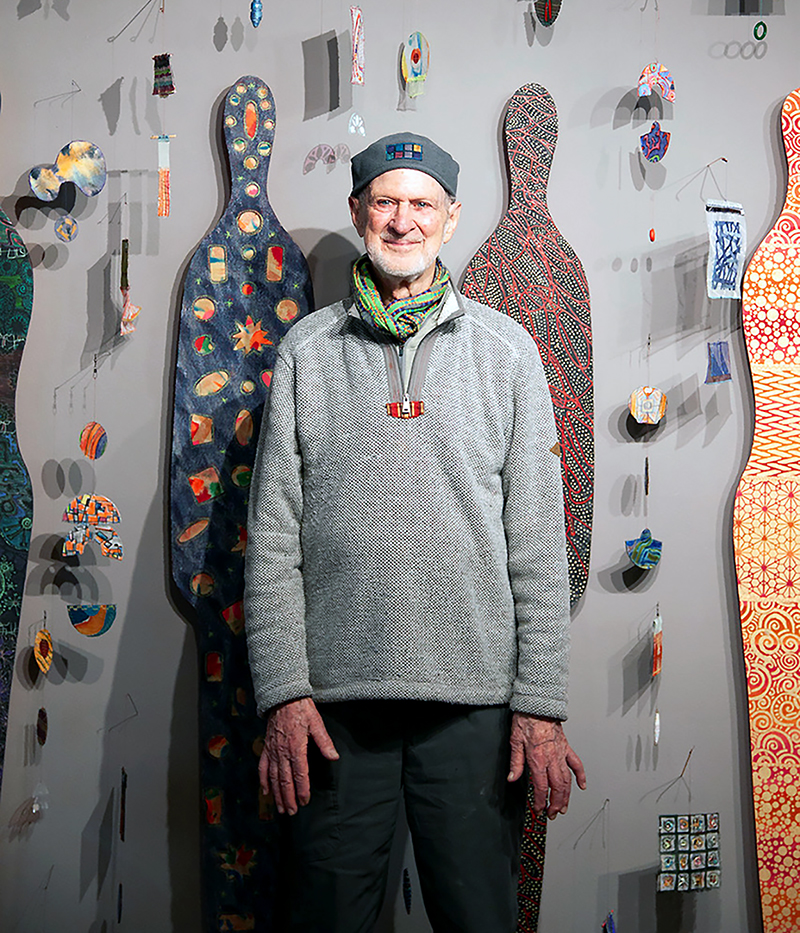Presented by Equity Bank

You never know where your creative life is going to take you.
That is especially true for internationally acclaimed artist Jason Pollen.
“I have been drawing, painting, collaging, designing, and stitching since I was a child,” Pollen relates. “Elaborate sandcastles were the first source of inspiration.”
Pollen studied and worked on the East Coast and in Europe, where he was on the faculty at the Royal College of Art in London as well as Parsons and Pratt in New York City. He came to the Kansas City Art Institute in 1983 and where he became Chair of the Fiber Department in 1997. Pollen left KCAI in 2010 to focus on his studio work.
“My art journey has been characterized by experimentation with process and materials, and the search for a compelling communicative visual language,” he says. “I have often felt as if I were a witness, watching my hands create something from nothing, then compelled to breathe as much life as possible into whatever has revealed itself.”
Pollen’s work is in many public and private collections, including the Smithsonian, Kemper Museum of Contemporary Art, and the Nerman Museum. He has designed sets for the Kansas City Ballet, for Haven (2005) and Carmen (2007).
Currently, he is professor emeritus at KCAI, president emeritus of the Surface Design Association, and is an American Craft Council Fellow. Most recently, his work has been exhibited at Leedy-Voulkos Art Center.
Pollen has also designed fabrics for a who’s who of institutions and fashion houses, including Chanel, Dior, Museum of Arts and Design, New York City Museum of Contemporary Art, Jack Lenor Larsen, Jim Thompson Thai Silks Ltd., Liberty of London, Donna Karan, and Oscar de la Renta.
Your work involves mixed materials, collaging, and fiber. How did you get interested in incorporating fabric?
I only veered away from exclusively using paint on canvas when I moved to Paris in the 60s. To support myself as a painter, I mastered textile design. Seeing the translation of designs on paper transformed into patterned fabrics led me to an interest in and fascination with fiber-art processes. After years of printing, painting, and stitching on silk, cotton and linen, I began and continue to use mixed-media approaches in the work.
You have designed fabric for major fashion houses. How and why did that come about?
As a textile designer living in Paris, fashion designers, (Chanel, Dior, Yves St. Laurent, et. al.) were those most interested in what I was creating. As a speaker of several European languages, I was able to sell designs to the fashion and home furnishing designers and manufacturers in France, Italy, Germany, and Switzerland.
Where do you find materials for your work?
All of my collages are created using scraps of the multitude of fabrics and sketch book pages I have created over many decades.
You came to Kansas City from the East Coast. What has surprised you about living here?
I moved here from New York City in 1983 to teach at KCAI. What surprised and delighted me most was the vibrant art and classical music communities here. Those communities have evolved to an astonishing degree since I came here. What also surprised and saddened me was the separation of the Black and white populations. This to my mind has not appreciatively improved.


